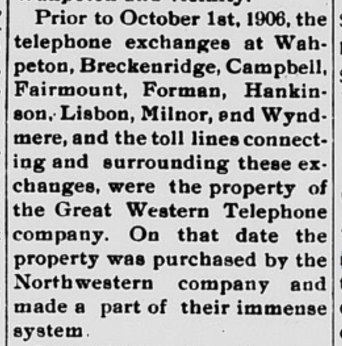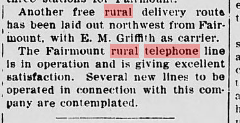|
As I wait for a technician to fix an appliance this morning, I started thinking about our ancestors and all the technology that evolved in the last 120 years. How can we can we tie early inventions and gadgets to our ancestors’ experience settling in the Midwest? Let’s explore. Today we take for granted the many appliances and technical wonders that are at our fingertips. Heaven forbid if our streaming services isn’t working and we’re unable to binge watch our favorite show! Many of the inventions that we take for granted today made our ancestors’ lives so much better daily. Inventions such as the telephone, electricity, radios and indoor plumbing and later washers and dryers, tractors all changed the landscape of the homesteader and their descendants. If you don’t have any family tales to tell you when Grandpa and Grandma no longer had to milk cows by lantern light, how can you find that information? While I won’t promise that you’ll find your specific ancestor’s record, you can get a general idea by studying information about where they lived. 1930 Census One of the few specific records that I know of that will tell you if your family owned a radio! Of course, your ancestor would need to answer the question. It’s worth looking around the pages before or after your person to see if most people did have a radio. In the example below, only five out of twelve families listed on that page had a radio in that rural township. A radio didn’t necessarily mean that they had electricity though…they might have a battery powered radio. Here’s an interesting site, Phil’s Old Radios, that talks about antique radios as well as a bit about the batteries used for those early models. County Histories When we look at local histories we often zoom in on the pages about our ancestors. It is worth reading about the township or nearby towns. While not specific to your ancestor, these histories give you an idea about the improvements in the communities. Here are a couple of excerpts from the Walsh Heritage A Story of Walsh County and Its Pioneers, Walsh County, North Dakota, published by the Walsh County Historical Society 1976. Hopefully this will give you an idea of the little gems hidden in these pages. On page 111 of Volume One, Walsh Heritage “In the first issue of The Walsh County Record published in 1890, it was reported that “the electric light company put in about 75 lights during the month of March. That is as it should be. The Record office is lighted by electric light and finds it very convenient.” On page 788 and 789 of Volume Two, Walsh Heritage: Early History of Adams “In August of 1906, three telephones were granted to the village for use in case of emergencies such as fire, illness, police, etc.; they were installed in the depot, post office and fire hall.” “The first electrical service for Adams was furnished by Ulysses Grant, who set up a small generating plant powered by an old automobile engine: later on, the town purchased a two-engine diesel plant. This unit furnished electricity until 10 p.m. on weeknights and a few hours on Sundays.” Well that would be interesting to only have electricity a few hours a night! If a town had this limited access to electricity, then it is likely rural areas nearby had no electrical access. Even telephones appear to be limited in availability. Local history online The State Historical Society of North Dakota has some excerpts about one woman’s experience as it relates to electricity, phone etc. This information is from the diaries of Pauline Olson. Here’s an excerpt from the site as well as a link regarding electricity. “Pauline began to keep a diary in 1926. Her six volumes might be called weather diaries because most of the entries detail weather conditions, but she also kept track of major family events, world affairs, sports news, and farm business. Occasionally she noted the arrival of new technologies that changed her life. Their farm was quite isolated: it was five miles from the tiny village of Souris and sixteen miles northwest of Bottineau. Telephones, first installed in 1905, connected them to their neighbors. Decades later, electricity allowed the Olsons to have television, indoor water, and appliances in their home.” You may find the series created for North Dakota teachers to use to teach history with primary sources useful as you work on your family histories. The first-person accounts of earlier days will trigger questions about your own family. Co-op History – The Dakota Valley Electric Cooperative provides a brief history of coops and how rural areas were finally able to have electricity. Try looking at your local library or online for histories of the cooperative in the area your ancestor lived. Newspapers Newspapers are more than a source of deaths, marriages and births. Using sites such as Chronicling America, you can find interesting articles about communities and technology. With this one newspaper article, you now know that at least there were phone lines from these southeastern North Dakota and western Minnesota towns prior as 1906. It may have been many years before rural people had phones but if you had an ancestor who lived in one of these cities, they had access to one. Here is another article about rural telephone lines northwest of Fairmount, North Dakota. Of course, if you have pictures, or family stories or old farm records, you’ll be able to uncover tidbits and figure out some of these key moments in their lives. Write about using telephone party lines or riding in the “rumble seat” of an automobile or harvesting with a combine instead of an entire threshing crew. Did your family have a washing machine that ran using a generator before electricity instead of hand washing? Think of the benefit of time and work saved by these inventions. I hope this has given you some ideas of where to search for information about those early conveniences may have been part of your ancestors’ lives. Happy searching!
For fun, here’s a blog article about telephone party lines. Does anyone remember them? They were around as late as the 1970s in rural America. Enjoy!
0 Comments
Leave a Reply. |
AuthorWith a lifelong passion for genealogy and history, the author enjoys the opportunity to share genealogy tidbits, inspiring others to research and write their family story. Archives
July 2024
Categories |







 RSS Feed
RSS Feed